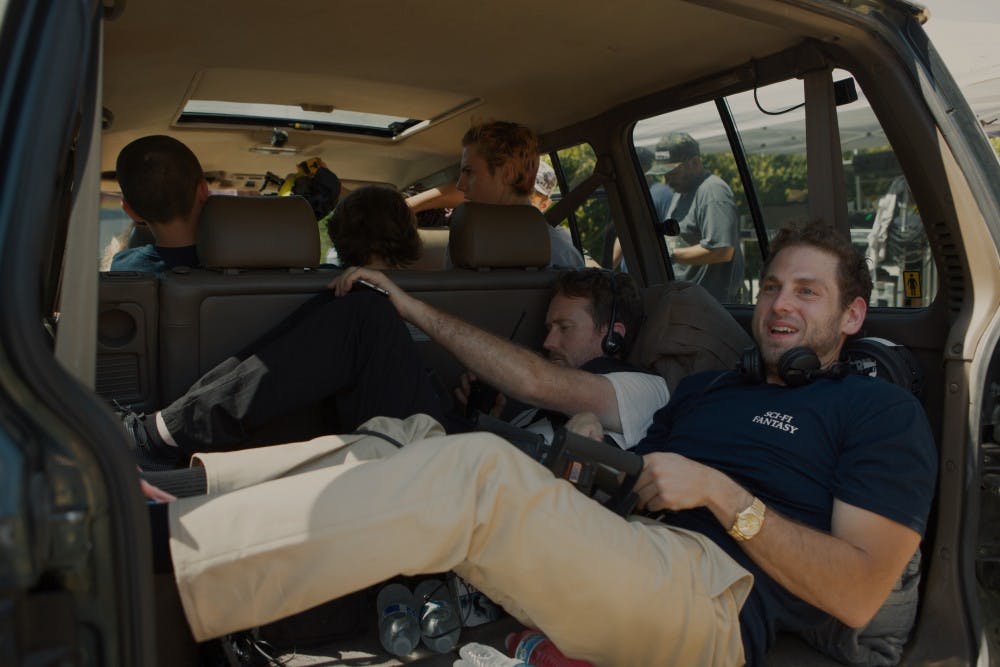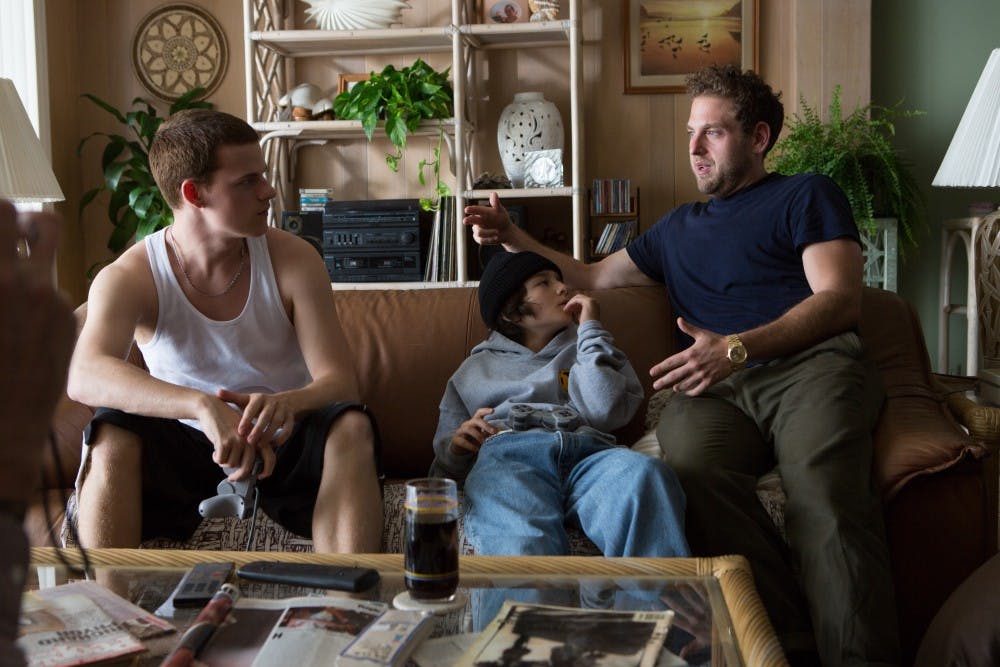There were highs and there were lows in Jonah Hill’s 10–year–long transformation from pudgy and easy–to–laugh–at Seth from Superbad to a fully–matured, elegant and brilliant director. There was that time he wore a fedora to a Superbad showing in 2007, but then there was also that time Jonah dyed his hair pink and looked better than anyone expected. But nothing will out–do this time where Jonah Hill takes a step outside of the camera shot and assumes his new role behind the camera on October 19th as the director of his first film “Mid90s.”
Based in 1990 Los Angeles, Mid90s is a coming–of–age, comedic–drama surrounding young, amateur skater Stevie as he seeks an escape from a tumultuous home life through skating, friendships, and partying. The film explores both the bitter and joyous emotions that accompany finding a space of belonging and in the process, sometimes pushing yourself too far or losing a sense of self. Although this film is honest about emotional growing pains, the audience also gets to see a true development of resilience and ambition as characters, despite difficult home lives, create honest friendships and aim for something greater in life.
Not many college students may be able to relate to being an aspiring or professional skateboarder, but the story of attempting to join an intimidating group is not unfamiliar. Whether you are a senior preparing to join the “real world” or a freshman first experiencing the turmoils of college, Mid90s has a story for all of us and within those stories, we all have a character whose shoes we have been in at some point or another. I was lucky enough to sit down with some of the cast from Mid90s to hear their insight on how they personally and how their characters navigated these sometimes awkward and uncomfortable, but ultimately invaluably rewarding situations.
The four actors I chatted with, Na–Kel Smith, Ryder McLaughlin, Olan Prenatt, and Sunny Suljic, are are all professional skaters from Los Angeles and this is precisely what sets Mid90s aside from other skate movies. These young men bring a refreshing dose of authenticity and honesty to the screen by transferring their real–life experiences and emotions to their characters’ on–screen stories. Equally impressively, Jonah Hill grew up skating in Los Angeles and can relate to everything he has written about in this script, although he asserts this is not an auto–biographical piece. Sunny Suljic, 13–year–old skater who plays lead–role as Stevie, noted that even as a pro–skater, Jonah Hill still knows more about skate culture and life than he does, demonstrating Hill’s dedication to creating a realistic and sincere skate movie. All four actors made the important distinction that “[Jonah] didn’t just have a skateboard” when he was young, “he was part of the culture.”

Credit: Tobin Yelland
In previous interviews with the Jonah Hill and the cast, they all worry about making a “nostalgia–porn or skate–porn” film, where the message can’t be transferred past the time period or sport to the majority of the population, who has experienced neither. The film includes some shots of impressive and exciting skateboarding tricks, but does not focus on dangerous stunts or unfathomable skating feats to express its purpose. The culture and importance of skating manifests in a growing sense of camaraderie and family that helps guide each of the boys in their personal lives. This is not to say that the boys only make fair and moral decisions throughout the film; rather contrarily, many mistakes are made and it can be upsetting to see their consequence played out on film, but that is what adds to the honesty of this story. According to Sunny, many other skate movies are disrespectful in how corny and stereotypically they portray skater culture. The difficult narratives of drugs, abuse, and loss in this script brings about an over–due depiction of the depth in skate culture. For the cast, some of the biggest misconceptions about skate life is that “people think [they’re] burnouts.” Although there is an air of angsty, anti–establishment sentiment portrayed in the film, Mid90s also clearly shows how skateboarding is a creative outlet that often times gives kids an alternative activity for community. Sunny spoke to how skate culture for him has really been “a supportive, big family [where] age difference is irrelevant.” For these boys, and their respective characters, the “skateboard is not a tool, but a lifestyle.”
Not only has skateboarding brought these kids a community and a family, but after the premiere of Mid90s, it has clearly demonstrated that this can be a career too. Through sponsorships, movies, and short-skate films, these young men have been able to make a living through skating. At a school like Penn, where many students are deciding on a major sometimes choose between fields of security and success as opposed to riskily pursuing personal passions, it is interesting to see how the cast has turned what they love into a successful career. Na–kel Smith, a 24–year–old from Los Angeles and sponsored by brands such as Adidas, Supreme, and Fucking Awesome, said that when growing up and learning to skate, he knew “it was possible to make a career, but never thought it was necessarily possible for [him].” He relayed the importance of “trusting yourself and believing in yourself” when it came to not abandoning passions and dreams. In the film, Na–kel’s character Ray is the ambitious one in the group of friends, who supposedly has the best shot of going pro, but he also deals with internal dilemmas of loyalty and loss. The narrative of Ray raises questions of what it takes to be successful and who you surround yourself with in the process. While experiencing diverging lives with his lifelong best friend, Fuckshit, Ray has to ask himself if he can afford to surround himself with the same drugs, alcohol, and partying anymore. Maybe we have different vices at school, or maybe we don’t, but regardless we can all still relate to the difficulties of finding people whose values align with our own and what to do when you realize maybe they don’t, once again showing how the relevance of Mid90s permeates its context.
Throughout the film, Stevie’s youthful idolization of Ray and the rest of the boys reminded me of the times I came into a group that was equally intimidating and fascinating; to be at a cross roads where you so want to be a part of something, but are equally scared to put yourself out there. Most of Mid90s revolves around finding a place of belonging and how you navigate a new community. After going through the process of entering skate culture on the fray, the boys had some opinions on this. Olan emphasized the importance of “integrity and being yourself” and Na–kel added on remembering “to stay in your lane” but also “to feel comfortable in your heart of hearts.” For Sunny, the youngest, he stressed the value in “being patient” until you find “real friends,” not just people who are fun to be around, but people who will have your back when it comes down to it. Sunny’s warning especially reminded me of how people view first–semester freshman year friendships and the value in being patient when finding your niche at college.
One of my favorite aspect of Mid90s is how it illustrates the creativity and artistry in skate culture, whether it be through the skate films made by Ryder McLaughlin’s character, FourthGrade, the individual skating style of each character, or the '90s fashion shown in the movie. Sunny spoke to the “art of skating” as “it’s never perfect” and Na–kel noted how there is “no stereotypical look” for skaters anymore, “all types of people are involved.” As much as the film is about family and brotherhood, skating is a sport that also promotes individuality and unique self–expression to differentiate yourself.
Mid90s is Jonah Hill’s debut as a director and what a startling debut it is; a visually beautiful and carefully crafted film that has a timeless message to all those that see it. Whether the young cast is portraying lessons of creating family, trying something new, pursuing your passion or expressing your individuality, if audiences are paying attention, they will surely learn something about themselves and the world around them. As generalizable as these lessons are, it does not discount the inside, honest, and much–needed glimpse into skate culture that Hill has provided. A community that has often been cast aside or regarded as juvenile by most, Hill has created a piece of art that you can show to your bitter grandma next time she complains about a sagging, baggy–clothed skateboarding punk that will turn her into a Thrasher–wearing, Vans–doting trendy bitch.

